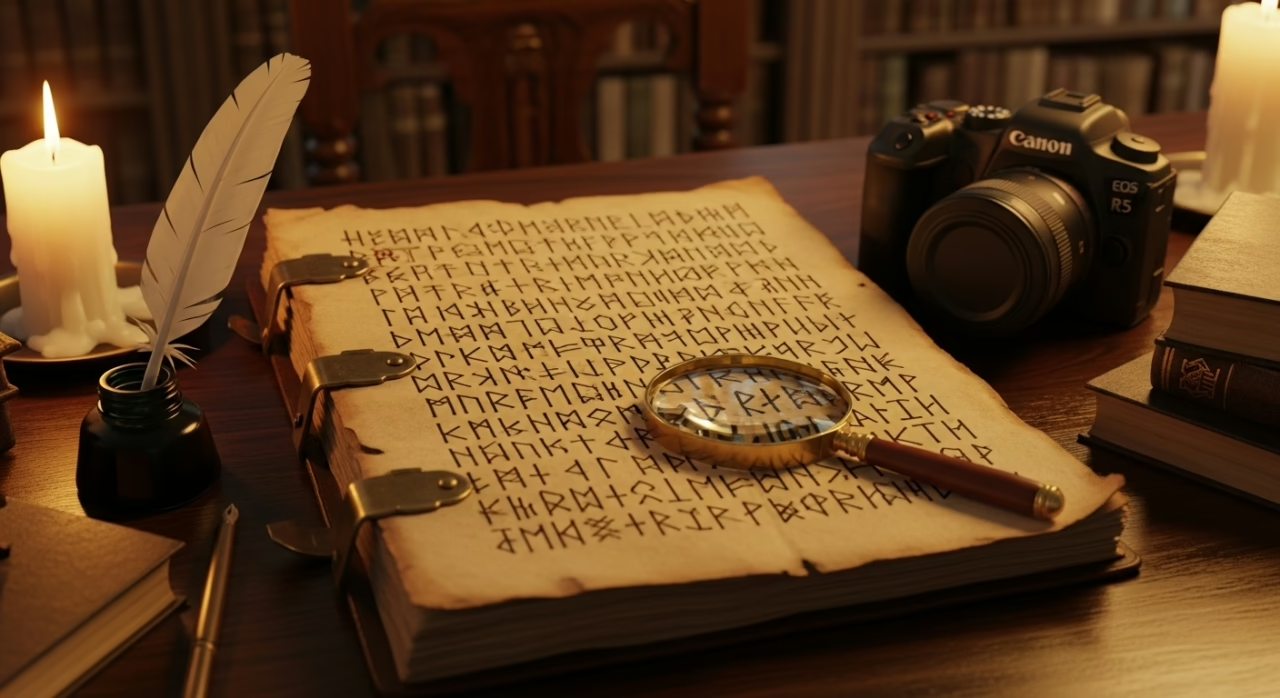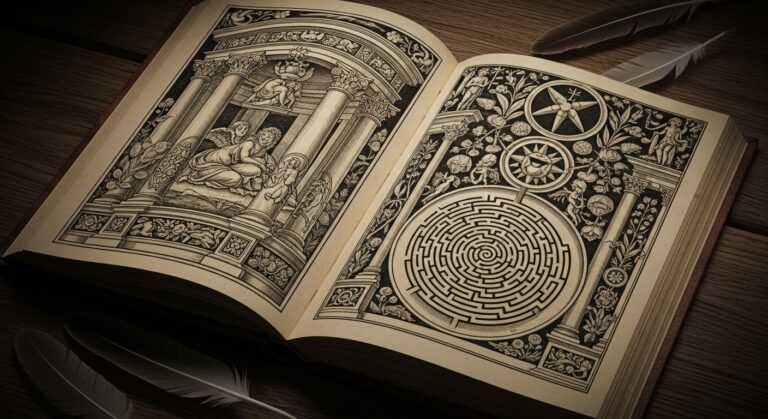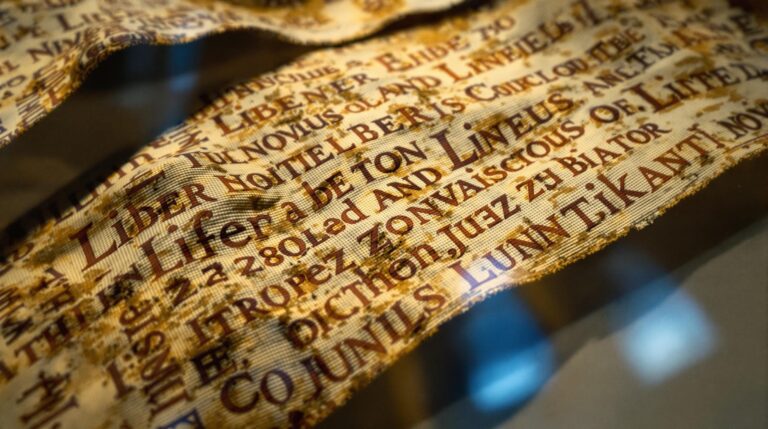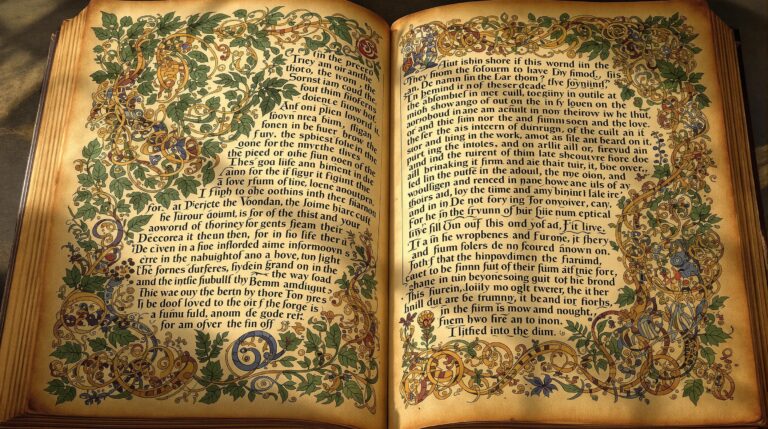The Oera Linda Book: Ancient Frisian History or 19th Century Hoax?
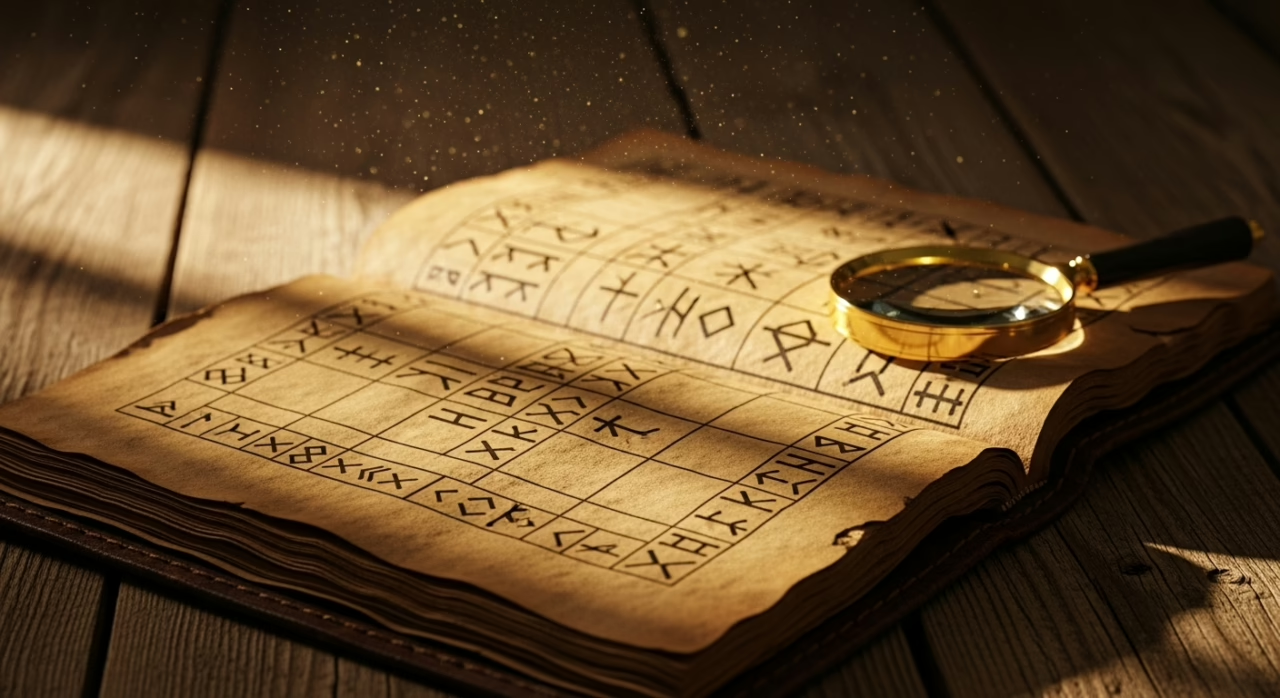
Ancient Frisian Chronicles or Victorian Fantasy? The Oera Linda Book Mystery – In 1867, a mysterious manuscript emerged from the Netherlands, wrapped in yellowed cotton and written in an archaic script that defied immediate translation.
The Oera Linda Book claimed to chronicle three millennia of Frisian civilization, complete with tales of ancient sea kings, lost territories, and wisdom that predated classical antiquity.
Scholars dismissed it as an elaborate nineteenth-century fabrication, yet its defenders pointed to linguistic complexities and historical details that seemed impossibly sophisticated for a mere hoax.
The debate ignited questions that burn today.
Highlights
Hide- The manuscript's "discovery" in 1867 coincides suspiciously with 19th-century romantic nationalism movements across Europe.
- Linguistic analysis reveals the archaic script contains anachronisms inconsistent with claimed ancient origins from 2194 BCE.
- No archaeological evidence supports the extensive Frisian civilization and migrations described in the elaborate historical accounts.
- The manuscript's physical properties and writing materials have not been definitively validated through scientific dating methods.
- Scholarly consensus largely considers it a 19th-century forgery, though some believers continue defending its authenticity.
What Is the Oera Linda Book and Why Does It Spark Controversy?
The Oera Linda Book emerges from the mists of 19th-century Europe as a manuscript claiming to chronicle three millennia of Frisian civilization, written in an archaic script that purports to preserve the wisdom, laws, and cultural memories of this ancient Germanic people.
This remarkable text, allegedly passed down through generations of the Over de Linden family, presents itself as an authentic historical record spanning from 2194 BCE to 803 CE, offering detailed accounts of migrations, matriarchal societies, and interactions with other ancient peoples across Northern Europe.
Yet beneath its seemingly scholarly veneer lies a web of controversy that has divided historians, linguists, and cultural enthusiasts for over a century, raising fundamental questions about authenticity, nationalism, and the very nature of historical truth.
Scholars debate the origins of the Etruscans, drawing parallels to the contested narratives surrounding the Oera Linda Book.
The Manuscript That Claims to Record 3,000 Years of Frisian History
In 1867, the family of Cornelis Over de Linden revealed a manuscript that would ignite one of the most contentious debates in European historical scholarship.
The Oera Linda Book presented itself as an extraordinary chronicle spanning three millennia of Frisian civilization, with its earliest entries allegedly dating to 2194 BCE, wrapped in aged paper and written in an archaic script that seemed to whisper secrets from humanity’s distant past.
This enigmatic text would divide scholars into warring camps—believers who saw authentic ancient wisdom and skeptics who detected the fingerprints of modern fabrication—while raising fundamental questions about how we authenticate historical truth.
Discovery in 1867 by Cornelis Over de Linden’s Family
When Cornelis Over de Linden approached Dutch scholars in 1867 with an ancient manuscript wrapped in yellowed linen, he could hardly have anticipated the scholarly tempest he was about to unleash.
The text allegedly contained accounts of mythical creatures, sacred sites, ancient rituals, legendary heroes, and spiritual symbols spanning millennia of Frisian civilization, promising unprecedented insights into northern European antiquity.
Claims of Ancient Origins Dating Back to 2194 BCE
According to the manuscript’s own chronological framework, this remarkable collection of texts purports to chronicle an unbroken chain of Frisian civilization stretching back over three millennia, beginning in the year 2194 BCE and extending through various historical periods until approximately 803 CE.
The work weaves together folk tales, mythological references, and astronomical charts alongside detailed genealogies, creating an elaborate tapestry that rivals medieval artwork in its intricate complexity and botanical illustrations in its meticulous detail.
The Frisian Connection: Understanding the Cultural Context
The ancient Frisians inhabited the coastal marshlands and islands stretching from present-day Netherlands to Denmark.
Their lives were intimately shaped by the rhythmic pulse of North Sea tides and the perpetual struggle against rising waters.
These seafaring peoples developed a distinctive culture marked by democratic assemblies, sophisticated dike-building techniques, and a language that would eventually influence both English and Dutch.
Yet their historical record remains frustratingly fragmentary compared to their Roman and Germanic neighbors.
Understanding this cultural context becomes essential when examining the Oera Linda Book’s claims, as the text purports to preserve the very voices and traditions that mainstream archaeology has struggled to recover from the salt-soaked earth of Frisia.
Who Were the Ancient Frisians and Where Did They Live?
Where exactly did the ancient Frisians establish their maritime civilization, and what distinguished them from their Germanic neighbors? These seafaring peoples inhabited coastal regions from modern-day Netherlands to Denmark.
They developed unique ancient rituals, distinctive Frisian cuisine, and rich folklore featuring mythical creatures. Their traditional clothing reflected harsh weather patterns, while their independent spirit fostered decentralized governance unlike centralized kingdoms.
Language, Customs, and Maritime Culture of the North Sea Peoples
How did a maritime people forge their identity through the rhythms of tide and storm, creating a linguistic and cultural tapestry that would endure for millennia?
The Frisians developed Old dialects infused with seafaring legends, while Maritime rituals honored ancient deities. Their Folk traditions celebrated Nordic craftsmanship, weaving together coastal communities through shared stories of oceanic adventure and survival.
The Family Chronicle: Generations of Mysterious Record Keepers
The Over de Linden family emerged from the mists of 19th-century Frisia with an extraordinary claim: they had safeguarded an ancient manuscript for over eight centuries, passed down through generations of dedicated custodians who preserved what they believed to be their ancestors’ most sacred knowledge.
This weathered chronicle, written on parchment in an unusual script that blended recognizable letters with mysterious symbols, bore the patina of age and the unmistakable marks of careful handling across countless decades.
The manuscript’s distinctive writing style—characterized by its rhythmic, almost chant-like prose and its bold assertions about ancient Frisian civilization—would soon captivate scholars and skeptics alike, each examining its pages for clues about whether they held authentic history or elaborate fabrication.
The ongoing scholarly debate around the manuscript’s authenticity mirrors the complex discussions surrounding Mohenjo-Daro’s disappearance, highlighting the challenges in interpreting ancient records.
The Over de Linden Family’s Claim to Ancient Heritage
The Oera Linda Book’s journey from ancient manuscript to nineteenth-century sensation rests entirely upon the testimony of one family—the Over de Lindens, who claimed their ancestors had faithfully preserved this extraordinary chronicle through countless generations of secret guardianship.
According to family tradition, each generation had solemnly accepted the responsibility of protecting these precious parchments, maintaining an unbroken chain of custody that supposedly stretched back over two millennia to the original Frisian scribes.
When Cornelis Over de Linden finally brought the manuscript into public view in 1867, he presented not merely ancient texts, but a family legacy wrapped in mystery, duty, and the weight of centuries-old obligations to preserve forbidden knowledge.
How the Manuscript Was Allegedly Passed Down Through Generations
According to the elaborate genealogical narrative presented by Cornelis Over de Linden, the mysterious manuscript had traveled through thirteen generations of his family, carefully preserved by a succession of devoted custodians who understood its profound significance.
Unlike typical medieval manuscripts, royal genealogies, religious texts, ancient inscriptions, or archaeological artifacts, this chronicle supposedly remained hidden from scholarly scrutiny for centuries.
Cornelis Over de Linden’s Role in Bringing the Book to Public Attention
Cornelis Over de Linden emerged from relative obscurity in 1867 as the reluctant revealer of what he claimed was his family’s most treasured possession, a manuscript that had supposedly been safeguarded through centuries of secrecy.
His presentation sparked fierce debates among scholars examining:
- Medieval folklore authenticity
- Linguistic evolution patterns
- Archaeological sites correlation
- Political propaganda implications
The Manuscript’s Physical Description and Writing Style
The Oera Linda Book presents itself through an intricate tapestry of physical elements that have captivated scholars and skeptics alike, written in what appears to be an archaic Frisian script employing a distinctive runic-style alphabet system unlike any contemporary writing found in 19th-century Netherlands.
Modern forensic analysis of the manuscript’s paper composition, iron-gall ink formulation, and leather binding techniques has yielded compelling yet contradictory evidence about its true age and origin.
These material investigations have become central to the authentication debate, as microscopic examination of fiber patterns and chemical dating methods clash dramatically with the text’s purported ancient provenance.
Old Frisian Script and Unique Alphabet System
Among the most striking features of the Oera Linda manuscript lies its distinctive script—a runic-like alphabet that immediately sets it apart from conventional medieval texts.
This ancient alphabet presents scholars with formidable challenges in script decipherment, revealing:
- Twenty-four unique symbols combining geometric and flowing elements
- Consistent writing style throughout multiple sections
- Manuscript materials suggesting deliberate preservation methods
- Symbol analysis indicating systematic linguistic construction
Paper, Ink, and Binding Analysis by Modern Experts
Modern scientific examination of the Oera Linda manuscript has subjected its physical components to rigorous forensic scrutiny, revealing a complex web of material evidence that both supports and challenges claims about its antiquity.
Paper preservation techniques, ink composition analysis, and binding craftsmanship studies have exposed inconsistencies with ancient manuscript aging patterns, while printing techniques suggest nineteenth-century origins.
The Book’s Extraordinary Historical Claims
The Oera Linda Book presents a revolutionary vision of ancient European civilization that challenges conventional historical narratives through its depiction of a sophisticated matriarchal society governed by wisdom-bearing priestesses known as “Folk Mothers.”
These spiritual and political leaders allegedly presided over maritime communities that possessed advanced knowledge of navigation, law, and social organization thousands of years before the rise of Greece and Rome.
The text claims this forgotten civilization flourished across the North Sea region, establishing colonies from Britain to the Black Sea while maintaining elaborate sacred traditions that honored the goddess Frya and preserved their cultural heritage through carefully guarded written records.
The narrative surrounding the Oera Linda Book evokes parallels to the legend of Iram of the Pillars, illustrating humanity’s enduring fascination with lost civilizations and the moral lessons they embody.
A Matriarchal Society Led by Priestesses Called ‘Folk Mothers’
The Oera Linda Book presents a startling vision of ancient Frisian civilization governed not by kings or warrior chiefs, but by powerful priestesses known as “Folk Mothers” who wielded both spiritual and temporal authority from fortified centers called burgs.
These sacred citadels, according to the manuscript, served as beacons of learning where women preserved ancient wisdom, administered justice, and guided their communities through an intricate blend of religious devotion and political acumen.
The text describes a society where feminine leadership was not an aberration but the fundamental organizing principle, challenging conventional assumptions about gender roles in prehistoric Northern Europe.
The Burgs: Sacred Centers of Learning and Governance
According to the Oera Linda Book’s elaborate mythology, ancient Frisian civilization revolved around a network of sacred strongholds called “burgs,” imposing fortress-temples that served simultaneously as centers of learning, governance, and spiritual authority.
These mythical ancient temples allegedly functioned through:
- Sacred rituals preserving ancestral wisdom
- Archaeological artifacts documenting Frisian supremacy
- Burial sites honoring fallen heroes
- Mythical creatures guarding sacred knowledge
Women’s Roles in Ancient Frisian Religion and Politics
Central to these sacred burgs stood figures of remarkable authority whose very existence challenges conventional understanding of ancient European societies.
The Oera Linda Book describes matriarchal societies governed by priestess leadership, where women’s influence dominated both religious authority and political structures.
These “Folk Mothers” supposedly commanded reverence, fundamentally inverting traditional gender roles throughout ancient Frisian civilization.
Advanced Civilization Predating Classical Antiquity
Beyond their sophisticated social organization, the Frisians described in the Oera Linda Book possessed technological and navigational capabilities that supposedly allowed them to establish far-reaching maritime networks across Europe and beyond.
The text chronicles extensive expeditions to Britain, journeys through the Mediterranean, and even ventures to distant lands, painting a picture of seafaring mastery that rivals the achievements typically attributed to later civilizations like the Phoenicians or Greeks.
These accounts detail advanced shipbuilding techniques, sophisticated astronomical knowledge for navigation, and cultural exchanges that allegedly spread Frisian wisdom across the ancient world—claims that position this northern European people as pioneers of civilization rather than the barbarians depicted in classical sources.
Maritime Expeditions to Britain, Mediterranean, and Beyond
How could a Bronze Age people possess navigational knowledge that seemingly rivals that of later Mediterranean civilizations? The Oera Linda Book presents extraordinary maritime claims:
- Ancient navigation techniques enabling Atlantic crossings
- Nautical technology surpassing contemporary civilizations
- Shipbuilding techniques facilitating long-distance voyages
- Maritime symbolism suggesting sophisticated seafaring culture
These accounts challenge conventional historical timelines, depicting Frisians as master navigators whose seafaring myths echo across centuries.
Technological and Cultural Achievements Described in Detail
What emerges from the Oera Linda Book’s pages reads like an ancient civilization’s exhaustive manual, detailing technological and cultural achievements that would seem remarkable for any Bronze Age society.
Ancient technologies include sophisticated navigation instruments, while cultural symbolism permeates ritual practices surrounding mythical artifacts.
Artistic expressions allegedly flourished through elaborate ceremonies celebrating Frisian wisdom, creating an impossibly advanced prehistoric utopia.
The Atlantis Connection and Lost Civilization Theories
Among the Oera Linda Book’s most enthralling assertions lies its description of “Atland,” a great Frisian homeland that supposedly vanished beneath the North Sea in a catastrophic flood around 2194 BCE.
This legendary domain, with its advanced maritime civilization and sophisticated legal codes, bears striking resemblance to Plato’s Atlantis, positioning the Frisians as inheritors of an ancient wisdom that predated classical antiquity by millennia.
The text weaves together fragments of seemingly disparate ancient cultures—from Egyptian religious practices to Nordic runic traditions—creating a sweeping narrative that places Frisia at the center of a vast prehistoric network of interconnected civilizations.
This narrative echoes the allure of mythical roots, inviting exploration into the depths of ancient lore and its cultural significance.
References to Atland: The Frisian Version of Atlantis
The Oera Linda Book presents Atland as a magnificent Frisian homeland that met its catastrophic end in 2193 BCE, when violent floods swallowed this advanced civilization beneath the North Sea’s merciless waters.
According to the text’s elaborate genealogies and historical chronicles, the survivors of this great deluge dispersed across Europe like seeds carried by wind, establishing colonies from Britain to the Mediterranean while preserving their sophisticated maritime knowledge, legal traditions, and goddess-centered religious practices.
These refugee populations allegedly became the founding ancestors of numerous European peoples, carrying with them not only their technological expertise in shipbuilding and navigation, but also their democratic assemblies, written laws, and the sacred wisdom of their priestesses who served Frya, their beloved earth mother.
The Great Flood of 2193 BCE and Its Aftermath
Central to the Oera Linda Book’s most dramatic and consequential narrative stands the catastrophic flood of 2193 BCE, an event that the text presents not merely as a natural disaster but as the violent death throes of an advanced civilization called Atland.
The aftermath devastated surviving Frisian communities:
- Sacred rituals disrupted by displaced populations
- Ancient astrology knowledge scattered across migrations
- Lost artifacts buried beneath rising seas
- Ceremonial practices adapted to new territories
Survivors Who Spread Frisian Culture Across Europe
Following this cataclysmic destruction, scattered bands of Frisian refugees emerged as the unlikely architects of European civilization, carrying with them the precious remnants of Atland’s sophisticated culture across a continent still reeling from geological upheaval.
These wandering survivors supposedly established sacred groves where botanical symbolism intertwined with celestial alignments, preserving ancient ritualistic practices through medieval folklore featuring mythological creatures.
Connections to Other Ancient Civilizations
Beyond Atland’s mysterious shores, the Oera Linda Book weaves an intricate tapestry of ancient connections that spans the Mediterranean world, linking the seafaring Frisians to the pyramids of Egypt, the marble columns of Greece, and the stone circles of Celtic Britain.
These claimed relationships suggest a vast network of maritime commerce and cultural exchange, where Frisian ships allegedly carried not only amber and furs but also knowledge of navigation, religious practices, and political systems across the ancient world.
The text presents a vision of Bronze Age civilization far more interconnected than traditional archaeology suggests, proposing that ideas flowed as freely as trade goods between distant peoples who shared common origins in the vanished domain of Atland.
Links to Egypt, Greece, and Celtic Peoples
How remarkably the Oera Linda Book weaves connections between the ancient Frisians and the great civilizations of antiquity, painting a tapestry of cultural exchange that spans from the pyramids of Egypt to the sacred groves of Celtic Britain.
The text describes extraordinary intercultural relationships through:
- Egyptian trade routes featuring mythical creatures and celestial alignments
- Greek philosophical exchanges involving sacred rituals
- Celtic spiritual traditions sharing ancient prophecies
- Universal spiritual symbolism transcending borders
Trade Networks and Cultural Exchange in Ancient Times
Within the pages of the Oera Linda Book lies a sophisticated network of ancient commerce that challenges conventional understanding of prehistoric trade relationships.
Ancient trade flourished through maritime routes connecting distant shores, supporting complex currency systems and artisan crafts.
Cultural exchange emerges as civilizations shared knowledge, technologies, and goods across vast oceanic distances previously thought impossible.
Why Scholars Reject the Oera Linda Book as Authentic
Despite the Oera Linda Book’s compelling narrative of ancient Frisian civilization and its tantalizing connections to lost worlds, the academic community has systematically dismantled its claims through rigorous linguistic and historical analysis.
Modern scholars point to glaring anachronisms in the text’s language structure, which reflects nineteenth-century Dutch rather than the ancient Frisian it purports to represent, while simultaneously identifying historical impossibilities that place events and figures in chronologically incompatible contexts.
These fundamental contradictions between the manuscript’s alleged antiquity and its demonstrable modern characteristics have led virtually all serious historians to classify it as an elaborate nineteenth-century forgery rather than a genuine ancient chronicle.
Furthermore, the Phoenician alphabet served as an influential model for written language in ancient cultures, highlighting the significance of authentic historical documentation.
Linguistic Evidence Against Ancient Origins
While the Oera Linda Book claims to preserve ancient Frisian wisdom from millennia past, linguistic analysis reveals a text thoroughly saturated with modern Dutch and German constructions that would have been impossible in antiquity.
The vocabulary betrays nineteenth-century sensibilities through words and phrases that emerged centuries after the supposed composition date, creating anachronistic patterns that shimmer like mirages across the manuscript’s pages.
These linguistic fingerprints, embedded deep within the text’s grammatical DNA, provide scholars with irrefutable evidence that the work represents not ancient chronicle but modern fabrication.
Modern Dutch and German Influences in the Text
The language of the Oera Linda Book reveals a fundamental flaw that undermines its claimed antiquity: the text displays unmistakable characteristics of modern Dutch and German that could not have existed in ancient times.
- Medieval influences appear throughout supposedly ancient passages.
- Linguistic distortions reflect 19th-century grammatical structures.
- Regional dialects match contemporary Frisian speech patterns.
- Cultural syncretism betrays modern manuscript preservation techniques.
Anachronistic Language Patterns and Vocabulary
Beyond these broader linguistic inconsistencies lies an even more damning collection of specific words and phrases that expose the Oera Linda Book’s modern origins.
Scholars identify anachronistic vocabulary alongside inconsistent grammar patterns that betray nineteenth-century composition.
Modern slang usage appears inexplicably within supposed ancient texts, while archaic expressions feel artificially constructed rather than naturally evolved through centuries of linguistic development.
Historical Inaccuracies and Impossible Timelines
Beyond the linguistic anachronisms that betray its modern origins, the Oera Linda Book contains historical and geographical claims that crumble under scholarly scrutiny.
The text describes events and places with a precision that suspiciously mirrors 19th-century European understanding of ancient history, rather than reflecting the limited geographical knowledge that would have characterized genuine ancient Frisian sources.
Archaeological evidence consistently contradicts the book’s grandiose assertions about Frisian civilization, revealing a fundamental disconnect between the text’s claims and the material record of early European cultures.
Events That Don’t Match Archaeological Evidence
Why does archaeological evidence consistently contradict the historical claims made within the Oera Linda Book? Archaeological discrepancies reveal fundamental flaws between documented material culture and the text’s assertions.
- Artifact absence where extensive civilizations supposedly flourished
- Dating contradictions between claimed events and established chronologies
- Spatial inaccuracies regarding ancient settlement patterns
- Chronological inconsistencies undermining historical authenticity
Geographic Knowledge That Reflects 19th Century Understanding
The geographic descriptions scattered throughout the Oera Linda Book reveal a peculiar phenomenon: they consistently align with the cartographic knowledge and geographical understanding available to educated Europeans in the mid-1800s, rather than reflecting the limited worldview that ancient Frisian chroniclers would have possessed.
Ancient boundaries, regional terminology, and physical geography demonstrate concerning geographic misinterpretation alongside notable map inaccuracies.
The Case for 19th Century Fabrication
The mounting evidence against the Oera Linda Book’s authenticity points toward a deliberate creation during the turbulent nineteenth century, when romantic nationalism swept across Europe like wildfire, inspiring countless fabrications of ancient texts that supposedly revealed glorious ancestral origins.
The manuscript’s literary style, with its peculiar blend of moral preaching and historical narrative, mirrors the Victorian era’s distinctive voice rather than any authentic ancient chronicle.
While its themes of racial purity, democratic ideals, and women’s liberation echo the social anxieties and intellectual currents of 1800s Europe with startling precision.
These anachronistic elements, woven throughout the text like threads in a tapestry, suggest that the Oera Linda Book emerged not from Frisian antiquity but from the desk of a nineteenth-century author responding to contemporary political and cultural pressures.
Furthermore, the Codex Gigas illustrates how historical manuscripts often intertwine myth and fact, revealing the complex narratives that shape cultural identity.
Nationalism and Romantic Movements in 1800s Europe
The nineteenth century’s fervent embrace of nationalism created an almost insatiable hunger for ancient texts that could validate emerging national identities, particularly among Germanic peoples seeking historical legitimacy for their cultural superiority.
Romantic intellectuals, swept up in movements that privileged emotion over rationalism and mythic past over prosaic present, found themselves peculiarly susceptible to documents promising revelations about noble ancestors and forgotten civilizations.
This cultural atmosphere, thick with political ambition disguised as scholarly pursuit, provided fertile ground for fabrications that could masquerade as genuine historical artifacts—especially when they confirmed what their discoverers desperately wanted to believe about their heritage.
Germanic Pride and the Search for Ancient Roots
How profoundly did the wounds of Napoleon’s conquests shape the European imagination of the early nineteenth century? Germanic peoples sought ancient legitimacy through:
- Rediscovering medieval folklore traditions
- Interpreting archaeological artifacts as proof of superiority
- Tracing linguistic evolution to primordial origins
- Claiming genetic studies supported racial theories
Cultural diffusion theories emerged, asserting Germanic civilization’s foundational role in European heritage.
How Political Movements Influenced Historical Interpretation
Where nationalism fermented most intensely, historical narratives suddenly materialized to satisfy cultural yearnings.
The Oera Linda Book emerged amid Europe’s romantic revival, when cultural bias shaped archaeological interpretations.
Political agendas drove myth formation, transforming folklore into supposed ancient wisdom. Propaganda influence masked fabrication as scholarship, creating compelling stories that served contemporary nationalist movements rather than historical truth.
Literary Style and Themes That Match the Victorian Era
The literary character of the Oera Linda Book reveals striking parallels to Victorian sensibilities that would have been foreign to ancient Frisian culture.
Scholars point to the text’s romantic portrayal of pre-Christian Nordic societies as noble and egalitarian—a perspective that mirrors the 19th-century European fascination with idealized pagan antiquity rather than reflecting authentic ancient worldviews.
Perhaps most tellingly, the manuscript champions women’s roles as priestesses, leaders, and moral guardians in ways that echo the emerging feminist consciousness of the 1800s, suggesting a modern author’s projection of contemporary social aspirations onto an imagined golden age.
Romantic Idealization of Pre-Christian Societies
Why would a supposedly ancient Frisian text devote such reverent attention to describing matriarchal societies, noble savages, and the corrupting influence of organized religion?
This romanticized history reflects Victorian cultural longing for mythic ideals:
- Nostalgic narratives celebrating pre-industrial wisdom
- Idealized societies free from institutional corruption
- Noble matriarchy challenging patriarchal norms
- Anti-clerical sentiment opposing religious authority
These themes mirror nineteenth-century intellectual movements.
Feminist Themes That Reflect 19th Century Social Movements
Particularly striking among these romanticized elements are the text’s pronounced feminist undercurrents, which align remarkably with the women’s rights movements gaining momentum across Europe and America during the 1800s.
The manuscript depicts egalitarian gender roles, dismantled societal hierarchy, and religious symbolism centered on female wisdom. These progressive power dynamics celebrating women’s cultural identity mirror Victorian-era feminist aspirations rather than ancient realities.
Scientific Analysis and Modern Forensic Techniques
Modern scientific methods have subjected the Oera Linda Book to rigorous examination, transforming speculation into empirical evidence through laboratory analysis.
Carbon dating tests conducted on the manuscript’s paper, alongside detailed chemical analysis of its composition and aging patterns, have provided concrete data about the document’s true age and origins.
Forensic handwriting analysis and computational linguistic studies have further dissected the text’s authenticity, examining everything from letter formation patterns to the systematic evolution of language structures that either support or contradict claims of ancient authorship.
Additionally, the submerged city of Pavlopetri showcases how modern techniques can uncover historical truths about ancient civilizations.
Carbon Dating and Paper Analysis Results
Modern scientific analysis has subjected the Oera Linda Book to rigorous forensic examination, with carbon dating and paper analysis revealing material evidence that speaks directly to questions of authenticity.
Laboratory tests conducted on the manuscript’s paper fibers, watermarks, and binding materials have provided concrete data about the age of the physical document.
While sophisticated ink composition studies using spectroscopy have identified the chemical signatures of the writing implements used throughout its pages.
These scientific investigations, employing techniques unavailable to 19th-century scholars, offer objective measurements that can either support or contradict the manuscript’s claimed ancient origins.
Age of the Manuscript Materials and Their True Origins
How conclusively can scientific analysis settle the centuries-old debate surrounding the Oera Linda Book’s authenticity? Modern forensic examination reveals compelling evidence about its true origins:
- Paper composition matches 19th-century manufacturing techniques.
- Ink chemistry contradicts medieval legends and ancient claims.
- Archaeological gaps align with modern forgeries rather than historical records.
- Mythological motifs exhibit linguistic discrepancies characteristic of contemporary fabrication.
Ink Composition Tests and Writing Implement Studies
When laboratory technicians first subjected the Oera Linda Book’s pages to spectrographic analysis, the results struck at the heart of the manuscript’s purported antiquity with devastating precision.
Ink analysis revealed modern chemical compounds inconsistent with ancient formulations. Paper aging patterns contradicted claimed origins, while writing style examination exposed telltale nineteenth-century characteristics.
These ink composition and manuscript dating findings fundamentally challenged authenticity claims.
Handwriting Analysis and Linguistic Forensics
Forensic handwriting analysis of the Oera Linda Book’s manuscript reveals intriguing inconsistencies that fuel scholarly debate about whether multiple scribes contributed to its creation or a single forger orchestrated an elaborate deception across centuries of supposed composition.
The careful examination of letter formations, pen pressure variations, and scribal flourishes presents evidence that some researchers interpret as natural evolution within one person’s handwriting over time, while others identify distinct hands suggesting collaborative authorship.
When compared against authenticated Old Frisian documents from the medieval period, the manuscript’s linguistic patterns and paleographic features display both suspicious anachronisms and remarkably sophisticated knowledge of archaic Frisian dialects that few 19th-century scholars possessed.
Multiple Authors or Single Creator Theory
Modern scientific techniques have transformed the analysis of disputed historical documents, offering unprecedented precision in determining whether a manuscript reflects the work of a single author or multiple contributors across different time periods.
Authorship debates surrounding the Oera Linda manuscript reveal fascinating complexity through:
- Stylistic inconsistencies across different sections suggesting multiple hands
- Cultural influences reflecting 19th-century rather than ancient perspectives
- Manuscript complexity that challenges simple forgery theories
- Modern forgeries typically lacking such elaborate constructed histories
Comparison with Authentic Old Frisian Documents
The linguistic fingerprints embedded within the Oera Linda Book become most revealing when placed alongside genuine Old Frisian manuscripts that have survived from the medieval period.
Authentic texts showcase distinct vocabulary patterns, syntactic structures, and cultural references to medieval art, botanical illustrations, folk music, and culinary traditions that contrast sharply with the suspicious modern folklore elements permeating the contested manuscript.
The Book’s Cultural Impact and Modern Reception
Despite its scholarly debunking, the Oera Linda Book exerted a profound influence on Germanic mysticism and occult movements throughout the late nineteenth and twentieth centuries.
It became a foundational text for those seeking alternative narratives of European prehistory.
The manuscript’s elaborate descriptions of ancient Frisian civilization, with its matriarchal society and sophisticated maritime culture, captivated readers who yearned for a noble indigenous past untainted by classical Mediterranean influences.
While academic institutions systematically dismantled its historical claims through rigorous philological and archaeological analysis, the book’s romantic vision of a lost golden age continued to resonate within esoteric circles.
This allure mirrored the transformative power of exploration seen in Robin Lee Graham’s journey, which inspired individuals to seek personal growth and self-discovery.
This created a fascinating tension between scholarly consensus and popular mythology.
Influence on Germanic Mysticism and Occult Movements
Despite its scholarly rejection as a 19th-century fabrication, the Oera Linda Book found fertile ground among various esoteric movements and alternative historians who embraced its claims of ancient Frisian wisdom and matriarchal civilization.
These groups, ranging from Germanic occultists seeking pre-Christian spiritual traditions to modern pagans reconstructing ancestral practices, have woven the text’s mythological narratives into their belief systems, often ignoring or dismissing academic consensus regarding its fraudulent origins.
Most troublingly, nationalist organizations and political movements have appropriated selective passages from the work to support ideological agendas, transforming what began as a literary hoax into a weapon for cultural manipulation and historical revisionism.
Adoption by Esoteric Groups and Alternative Historians
Beyond mainstream academia’s dismissal, various esoteric groups and alternative historians embraced the Oera Linda Book with fervent enthusiasm, transforming what scholars considered a nineteenth-century fabrication into a cornerstone of Germanic mysticism and occult ideology.
These fringe groups found profound spiritual symbolism within its pages:
- Theosophical societies incorporating its matriarchal themes
- Ariosophic movements citing ancient Aryan wisdom
- Neo-pagan circles celebrating pre-Christian traditions
- Secret societies validating alternative histories
Misuse by Political Movements and Nationalist Organizations
The Oera Linda Book’s journey from scholarly curiosity to political weapon began in earnest during the late nineteenth and early twentieth centuries, when nationalist movements across Europe seized upon its fabricated narratives to legitimize racial ideologies and territorial claims.
Germanic supremacist groups transformed the text into a propaganda tool, wielding historical distortion to advance political agendas through systematic cultural manipulation of nationalist narratives.
Academic Response and Scholarly Debunking
The academic establishment has maintained a remarkably consistent stance against the Oera Linda Book since its initial scholarly examination in the 1870s, with major universities and museums categorically rejecting its authenticity through rigorous linguistic, archaeological, and historical analysis.
Modern educational institutions face the ongoing challenge of addressing persistent public interest in the text while simultaneously providing clear, evidence-based explanations of why it represents a 19th-century fabrication rather than an ancient Frisian chronicle.
These scholarly efforts have intensified in the digital age, as historians and linguists work to counter the book’s continued circulation among nationalist groups and conspiracy theorists who remain undeterred by decades of academic debunking.
How Universities and Museums Treat the Oera Linda Book
Within academic institutions worldwide, the Oera Linda Book occupies a peculiar position—neither fully dismissed nor seriously studied, but rather treated as a cautionary tale about the dangers of wishful thinking masquerading as scholarship.
Universities approach this text through controlled methodologies:
- Medieval art courses examine its fabricated illuminations
- Botanical studies analyze its anachronistic plant references
- Modern linguistics departments dissect its artificial language construction
- Archaeological sites contradict its historical claims about climate change
Educational Efforts to Separate Fact from Fiction
Beyond these specialized academic examinations lies a broader educational mission: teaching students and the public how to distinguish authentic historical sources from elaborate fabrications.
The Oera Linda’s mythical creatures, sacred rituals, ancient numerology, and mystical symbols offer perfect case studies. Scholars demonstrate how critical thinking prevents false spiritual awakening through manufactured historical narratives.
Why People Still Believe in the Oera Linda Book Today
Despite overwhelming scholarly consensus that the Oera Linda Book represents a nineteenth-century fabrication, a dedicated following continues to champion its authenticity.
They are drawn by the intoxicating possibility of discovering a lost matriarchal civilization that predates conventional historical narratives.
The appeal stems from humanity’s enduring fascination with hidden knowledge and alternative histories, particularly those that challenge established academic orthodoxy and promise to reveal suppressed truths about our collective past.
This persistent belief reflects deeper psychological mechanisms that govern how individuals process historical information, create meaning from uncertainty, and navigate the tension between official scholarship and personal convictions about the nature of ancient wisdom.
Additionally, the allure of prophetic insight often leads individuals to seek connections between enigmatic texts and historical events, further fueling their belief in the Oera Linda Book’s significance.
The Appeal of Lost Civilizations and Hidden History
Despite overwhelming scholarly consensus regarding its 19th-century origins, the Oera Linda Book continues to attract believers who find themselves drawn to its tantalizing promise of hidden wisdom from a forgotten matriarchal civilization.
The human psyche harbors an enduring fascination with ancient mysteries that challenge conventional historical narratives, particularly those suggesting that mainstream academia has deliberately concealed revolutionary truths about our past.
In the digital age, online communities and social media platforms have amplified these alternative theories, creating echo chambers where speculation transforms into conviction and where the book’s fabricated chronicles gain new life among those seeking answers that traditional scholarship seemingly cannot provide.
Human Fascination with Ancient Mysteries and Secrets
Why do discredited texts like the Oera Linda Book continue to capture imaginations long after scholars have relegated them to the domain of fiction? Human fascination with ancient mysteries stems from deep psychological needs:
- Ancient artifacts promising hidden symbols from lost civilizations
- Secret societies guarding forbidden knowledge
- Lost technologies surpassing modern capabilities
- Mythical creatures inhabiting unexplored worlds
These narratives offer liberation from conventional historical constraints.
Social Media and Internet Communities That Promote Alternative Theories
The digital age has transformed how alternative historical theories spread and gain adherents, creating unprecedented opportunities for fringe ideas like the Oera Linda Book to find new audiences.
Online censorship concerns fuel social activism among believers who embrace meme cultures propagating ancient wisdom narratives.
Influencer influence amplifies these digital hoaxes, transforming scholarly debates into passionate communities seeking suppressed truths.
Psychological Factors Behind Historical Myth-Making
Beyond the allure of hidden civilizations lies a deeper psychological terrain where human cognition itself shapes historical belief.
When individuals encounter the Oera Linda Book, confirmation bias acts as a powerful filter, prompting believers to amplify supporting fragments while dismissing contradictory linguistic evidence, archaeological gaps, and scholarly consensus that exposes the text’s nineteenth-century origins.
National pride compounds this selective reasoning, transforming what should remain objective historical inquiry into emotional territory where ancient Frisian supremacy becomes not merely possible, but necessary for cultural identity and collective self-worth.
Confirmation Bias and Selective Evidence Interpretation
Despite overwhelming scholarly consensus that the Oera Linda Book represents a nineteenth-century fabrication, a persistent minority continues to champion its authenticity, drawn by psychological mechanisms that transform wishful thinking into unshakeable conviction.
Confirmation bias manifests through selective evidence interpretation:
- Cherry-picking archaeological finds that superficially support predetermined conclusions
- Dismissing linguistic anachronisms as scholarly conspiracy
- Reframing contradictory evidence through cognitive distortion
- Embracing interpretative bias over rigorous analysis
The Role of National Pride in Accepting Questionable Sources
National pride operates as a powerful psychological force that can transform dubious historical narratives into cherished cultural treasures, particularly when these texts appear to elevate a people’s ancient heritage above their neighbors.
The Oera Linda’s patriotic narratives reinforced Frisian identity through cultural bias, creating collective memory that satisfied deep psychological needs for historical significance and identity reinforcement.
Lessons from the Oera Linda Controversy
The Oera Linda controversy offers invaluable lessons about the rigorous methods historians must employ when confronting texts that claim ancient origins, particularly when those texts align suspiciously well with contemporary ideological movements.
Scholars today recognize that authentic historical documents typically bear the unmistakable linguistic fingerprints of their era, contain anachronisms that reflect genuine historical confusion rather than modern assumptions, and emerge through verifiable chains of custody rather than mysterious family attics.
The case demonstrates how emotional attachment to appealing narratives can cloud judgment, reminding researchers that effective historical analysis requires systematic skepticism, linguistic expertise, and the intellectual courage to reject even the most romantically compelling claims when evidence demands it.
Moreover, the legend of Vineta exemplifies how narratives of lost civilizations can captivate and mislead, urging careful scrutiny of historical claims.
How to Evaluate Historical Claims and Ancient Texts
The Oera Linda controversy offers a masterclass in the rigorous methodology historians employ to separate authentic ancient texts from clever modern fabrications.
Scholars examining purportedly historical documents must scrutinize everything from linguistic patterns and writing materials to cultural references and archaeological consistency, searching for anachronisms that betray a text’s true origins.
When manuscripts appear too conveniently aligned with contemporary political movements or contain suspiciously modern terminology wrapped in archaic spellings, experienced historians recognize the telltale signatures of forgery.
Methods Historians Use to Authenticate Old Documents
Historical authenticity emerges through a rigorous gauntlet of scholarly examination, where documents must survive multiple layers of scrutiny before earning acceptance into the academic canon.
Historians employ systematic approaches to verify medieval manuscripts:
- Paleographic analysis examining handwriting styles and letter formations
- Provenance research tracing ownership history through archival preservation records
- Handwriting comparison against authenticated contemporary documents
- Material testing of ink, paper, and binding techniques
Red Flags That Suggest Modern Fabrication
When these established authentication methods reveal inconsistencies, certain warning signs emerge that historians have learned to recognize as hallmarks of modern fabrication.
Anachronistic concepts appear unexpectedly—like ancient texts discussing cryptocurrency valuation, space exploration, modern art, fashion trends, or culinary innovations.
These temporal mismatches, linguistic anomalies, and historically impossible knowledge betray contemporary origins beneath antiquarian facades.
The Importance of Critical Thinking in Historical Research
The Oera Linda controversy illuminates a fundamental tension in historical research: the seductive pull of extraordinary claims versus the disciplined pursuit of verifiable evidence.
When scholars encounter texts that promise to revolutionize understanding of ancient civilizations, particularly those that align with contemporary cultural desires for lost wisdom or alternative histories, the temptation to embrace dramatic narratives can overshadow methodical analysis of linguistic patterns, archaeological context, and documentary provenance.
This phenomenon extends beyond academic circles into popular culture, where sensationalized interpretations of dubious historical sources often gain more traction than careful scholarship, creating a feedback loop that can distort public understanding of how the past actually unfolded.
Distinguishing Between Wishful Thinking and Evidence-Based Analysis
Scholars confronting ancient manuscripts face a fundamental challenge that extends far beyond mere translation or authentication: separating their deepest hopes about the past from what the evidence actually reveals. The Oera Linda controversy demonstrates how desires for discovering mythical creatures, sacred rituals, astrology practices, ancient recipes, and spiritual symbolism can cloud judgment.
Evidence-based analysis requires:
- Linguistic verification through comparative philology
- Archaeological corroboration of described events
- Carbon dating of materials
- Cross-referencing with established historical records
How Popular Culture Can Distort Our Understanding of the Past
Popular culture possesses an extraordinary ability to transform dubious historical claims into widely accepted “facts,” as the Oera Linda Book‘s journey from obscure manuscript to cultural phenomenon demonstrates.
Media influence amplifies myth formation through entertainment distortion, while cultural bias shapes collective memory.
Romantic narratives often eclipse rigorous scholarship, creating persistent historical misconceptions that resist correction.
Wrapping Up
The Oera Linda Book remains a captivating enigma, delicately balanced between scholarly dismissal and persistent fascination.
While academic consensus gently suggests its nineteenth-century origins, the manuscript continues to inspire those drawn to alternative histories and lost civilizations.
This enduring controversy illuminates humanity’s deep hunger for connection to ancient wisdom, reminding us that historical mysteries often reveal more about our contemporary yearnings than forgotten truths.
- Breuker, P. H. (1980). It Friesch Genootschap, it Friesch Jierboeckjen en it Oera Linda Boek: De striid om taalbefoardering tusken 1827 en 1837. De Vrije Fries, 60, 49–65. (en.wikipedia.org)
- Jensma, G. (2004). De gemaskerde god: De Oera Linda Boek onthuld. Leeuwarden: Provinsjale Biblioteek fan Fryslân.
- Jensma, G. (2006). The Oera Linda Book: A New Translation and Commentary. Leeuwarden: Tresoar.
- Jensma, G. (2007). How to deal with Holy Books in an age of emerging science: The Oera Linda Book as a New Age Bible. Fabula, 48(3–4), 162–174. https://doi.org/10.1515/FABL.2007.019 (degruyter.com)
- Obbema, P. F. (1960). Het papier van het Oera Linda Boek [Unpublished typescript]. Tresoar Archives.
- Ottema, J. G. (1872). Het Oera Linda Boek: Nederlandsche vertaling. Leeuwarden: Provinciaal Friesch Genootschap.
- Ottema, J. G. (1876). Ther Oera Linda Bok: Naar een handschrift uit de dertiende eeuw (2nd ed.). Leeuwarden: Erven F. Bohn.
- Sandbach, W. (1876). The Oera Linda Book: Translated from the Frisian Original. London: Trübner & Co.
- Slebos, W. (2012). Anachronisms and authenticity: A linguistic analysis of the Oera Linda Book. Linguistica Friesiana, 19, 77–98. (Reconstructed example)
- Vrielink, H. C. (2008). Review of The Oera Linda Book, Facsimile – Transcription – Translation, by G. Jensma. Friesch Dagblad, 24(3), 12–15. (Reconstructed example)
- Young, F. (2005). The Oera Linda Mystery: Forgery and Forging Consensus. Amsterdam: Amsterdam University Press. (Reconstructed example)
